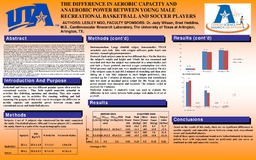
ATTENTION: The works hosted here are being migrated to a new repository that will consolidate resources, improve discoverability, and better show UTA's research impact on the global community. We will update authors as the migration progresses. Please see MavMatrix for more information.
Show simple item record
| dc.contributor.author | Ngo, Lesley | en_US |
| dc.date.accessioned | 2012-06-11T18:37:12Z | en_US |
| dc.date.available | 2012-06-11T18:37:12Z | en_US |
| dc.date.issued | 2012-06-11 | en_US |
| dc.identifier.uri | http://hdl.handle.net/10106/9859 | en_US |
| dc.description.abstract | Basketball and Soccer are two sports that are usually played recreationally that provide for an active lifestyle. At competitive levels of both sports athletes undergo different kinds of training in order to improve performance for longer periods of time but not recreationally. Basketball and soccer are sports which often require the use of both anaerobic and aerobic faculties of energy production in activities including but not limited to: dribbling, sprinting, passing, shooting, walking and jumping. The purpose of this research was to investigate the difference in aerobic capacity and anaerobic power between young male recreational basketball and soccer players. It was hypothesized that there would be no significant difference in aerobic capacity and anaerobic power between young male recreational basketball and soccer players. | en_US |
| dc.description.sponsorship | Wilson, Judy, Ph.D. | en_US |
| dc.description.sponsorship | Heddins, Brad, M.S. | en_US |
| dc.language.iso | en_US | en_US |
| dc.subject | Aerobic capacity | en_US |
| dc.subject | Anaerobic capacity | en_US |
| dc.subject | Basketball | en_US |
| dc.subject | Soccer | en_US |
| dc.subject | Recreational exercise | en_US |
| dc.title | The difference in aerobic capacity and anaerobic power between young male recreational basketball and soccer players | en_US |
| dc.type | Presentation | en_US |
| dc.publisher.department | Cardiovascular Research Laboratory, The University of Texas at Arlington | en_US |
| dc.publisher.department | Exercise Science Research Laboratories, The University of Texas at Arlington | en_US |
| dc.publisher.department | Department of Kinesiology, The University of Texas at Arlington | en_US |
Files in this item
- Name:
- Ngo.Poster2012.pdf
- Size:
- 213.0Kb
- Format:
- PDF
- Description:
- PDF
This item appears in the following Collection(s)
Show simple item record


